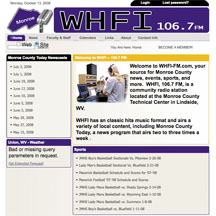Once upon a time, the Monroe County School Board had a 5000-watt radio station called WHFI-FM. Few in the community listened to the station, which broadcast from the Monroe County Technical Center. In 2006, West Virginia University’s P.I. Reed School of Journalism took notice of this under-utilized community resource and offered to help, with an infusion of journalistic training and guidance from WVU students and faculty. They called it the Monroe County Radio Project.
 The past two years have seen some ups and downs in this long-distance university-school-community partnership. But now, WHFI has racked up a nice list of bragging rights. The station has:
The past two years have seen some ups and downs in this long-distance university-school-community partnership. But now, WHFI has racked up a nice list of bragging rights. The station has:
- Produced and aired more than 140 local newscasts.
- Launched a website, which includes audio files of the newscasts.
- Expanded bi-weekly newscasts from 5 to 15 minutes.
- Produced other local programs such as “The Best Bands You’ve Never Heard,” which showcases local performers.
- Covered and aired other community events
- Generated additional revenue, including $4,800 in local business underwriting, $10,000 in sponsorship of sports broadcasts and $15,000 in federal and community foundation grants.
- Developed partnerships with many local organizations and media.
“While we did not accomplish everything we set out to do in the original grant proposal, the Monroe County Radio project has been a success on a number of levels.” says Maryanne Reed, the project director and dean at the journalism school.
“Most importantly, the project is a success because it has planted the seeds for future growth and development. When we started, WHFI was a station that played automated music and aired very little public affairs programming and no local news. Now the precedent has been established that WFHI is a news source — a place where individual citizens and groups have their issues and events covered and where local voices are heard on the radio,” says Reed.
The station’s coverage of the Virginia Tech shootings in nearby Blacksburg helped establish its reputation as a source for local information. Reed says local residents who were unable to attend James Monroe High School’s graduation ceremony in June 2008 appreciated they could listen to the station’s live broadcast of this special event. Live broadcasts of high school football and basketball games are very popular. According to Reed, “When Monroe High School made it to the state football championship, the station carried the game in its entirety, allowing people who couldn’t make the six-hour drive to Wheeling the opportunity to experience the game nearly first-hand.”
Beyond the anecdotes, one solid piece of evidence that WHFI has become accepted as a news source in the community is that county has designated the station an “Emergency Broadcast Station.” “In a very small, rural community, such a designation is vital,” says Reed, “because it indicates that the radio station is the source of news and information during a weather disaster or other major crises.”
The community is not only listening to WHFI, they’re talking back. The station has noticed a dramatic increase in the number of phone calls from listeners commenting on stories and a spike in press releases and advisories from local organizations seeking coverage of their events. “There seems to be a ‘buzz’ in the community about the station and its programming,” says Reed.
Reed is most proud of the WVU students’ involvement in the project. Over the two-year period, two teams of WVU journalism majors traveled to Monroe County to work with local students and adult volunteers. They taught them how to use Cool Edit software, coached them on what makes a story newsworthy, and how to write for radio. Reed says many of her students describe their experience with the Monroe County Radio Project as the highlight of their college career.
Above all, though, is the impact the project has had on the community. Reed says it has demonstrated to the citizens of Monroe County the radio station’s potential as a vehicle for citizen engagement. “The community is scattered across a wide geographic area, and it may not always been apparent to the residents that they share common interests and goals,” says Reed. “The opportunity for the community to coalesce around certain issues, such as the impact of housing development on family farming, has been demonstrated to some extent through the coverage of these issues.”
Looking back on the past two years, Reed recommends that other citizen media projects really take the time to listen and learn about the local community, the key players and work hard to establish trust. At first, the university folks came to town with big ideas and a clear agenda, but found it hard to find local acceptance, buy in or enthusiasm.
“We learned that to build support for news, a station might need to provide residents with other types of programming, such as live coverage of sports and other milestone community events,” reflects Reed. While journalists’ definition of “news” is based upon a public affairs model, many people have a broader interpretation of what is newsworthy and valuable to them.”
In the coming months, the school district will assume responsibility for managing the Monroe County Radio Project. In anticipation of that transition, Reed will try to secure a VISTA worker for WHFI who can offer professional support to keep it going strong. The district has committed to fund a half-time station manager and WHFI hopes to raise enough funds to make that manager full-time.



